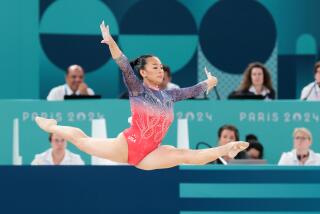Troupe in getting-acquainted mode
At her best, choreographer Hae Kyung Lee can alter oneâs perception, transforming bone and muscle into a field of fluctuating vibration or flowing motion. Indeed, with her proclivity for combining the meditative with the highly athletic, perceptual flux is necessary for the work to cohere into something more than an amalgamation of opposing energies and elements.
Otherwise, Leeâs dances can look overstuffed and, well, just plain awkward. Such was the case Saturday night at an untitled concert by Hae Kyung Lee and Dancers in Cal State L.A.âs State Playhouse.
Introducing a new troupe as well as a new work alongside two older pieces, Lee made a gamble that didnât pay off, with young, inexperienced dancers struggling with the basics of her choreography when so much depends on how it is performed.
In the premiere, âDivination,â no wellspring of wisdom could be found, although one might surmise from Laura Freconâs brazen silver costumes and Christopher Kuhlâs resplendent rainbow-hued lighting design that the future looks bright to Lee. Here, Lee relied on a balletic movement vocabulary, rife with pique arabesques, to communicate joyous uplift. Yet the danceâs continual upward surging made abrupt drops into shoulder stands difficult for the dancers and incomprehensible to the audience. Where was the rooted strength that is a signature of Leeâs work?
Composer Robert Eenâs lyrical score for accordion, cello and percussion propelled the dance forward despite the effortful, leaden pacing of the dancers.
The capacity to infuse meaning into motion could be found in âBlank Slate,â however, thanks to Kishisa Ross, the remaining old-timer of the group. In stark contrast to âDivination,â this 1998 work isolated pairs of dancers -- Ross and Melissa Manzo; Yvette Alawerdjian and Eric Perez; Edgar Miramontes and Tommy Lee -- in dramatic pools of light, intimate islands in a sea of darkness that engulfed the stage.
Accompanied by longtime Lee collaborator Steve Moshierâs equally dark, bellowing electronic score, the duets sifted through an array of sculptural poses and a few impressively risky partnering combinations, seen first in a series of brief flashes, then in extended sequences that contrasted Ross and Manzoâs liquid extensions with Miramontes and Leeâs frenetic thrashing.
The program concluded with 1999âs âConfrontation,â featuring the ensemble in black trench coats tripping and stumbling in increasingly gymnastic passes across the stage. Whether all this was meant in homage to film noir or slapstick comedy was uncertain, though Moshierâs ominous score seemed to indicate the former.
The determination with which Hae Kyung Leeâs new ensemble performed bodes well for the future. They have the heart -- now they need to find the soul of her dances.
More to Read
The biggest entertainment stories
Get our big stories about Hollywood, film, television, music, arts, culture and more right in your inbox as soon as they publish.
You may occasionally receive promotional content from the Los Angeles Times.










